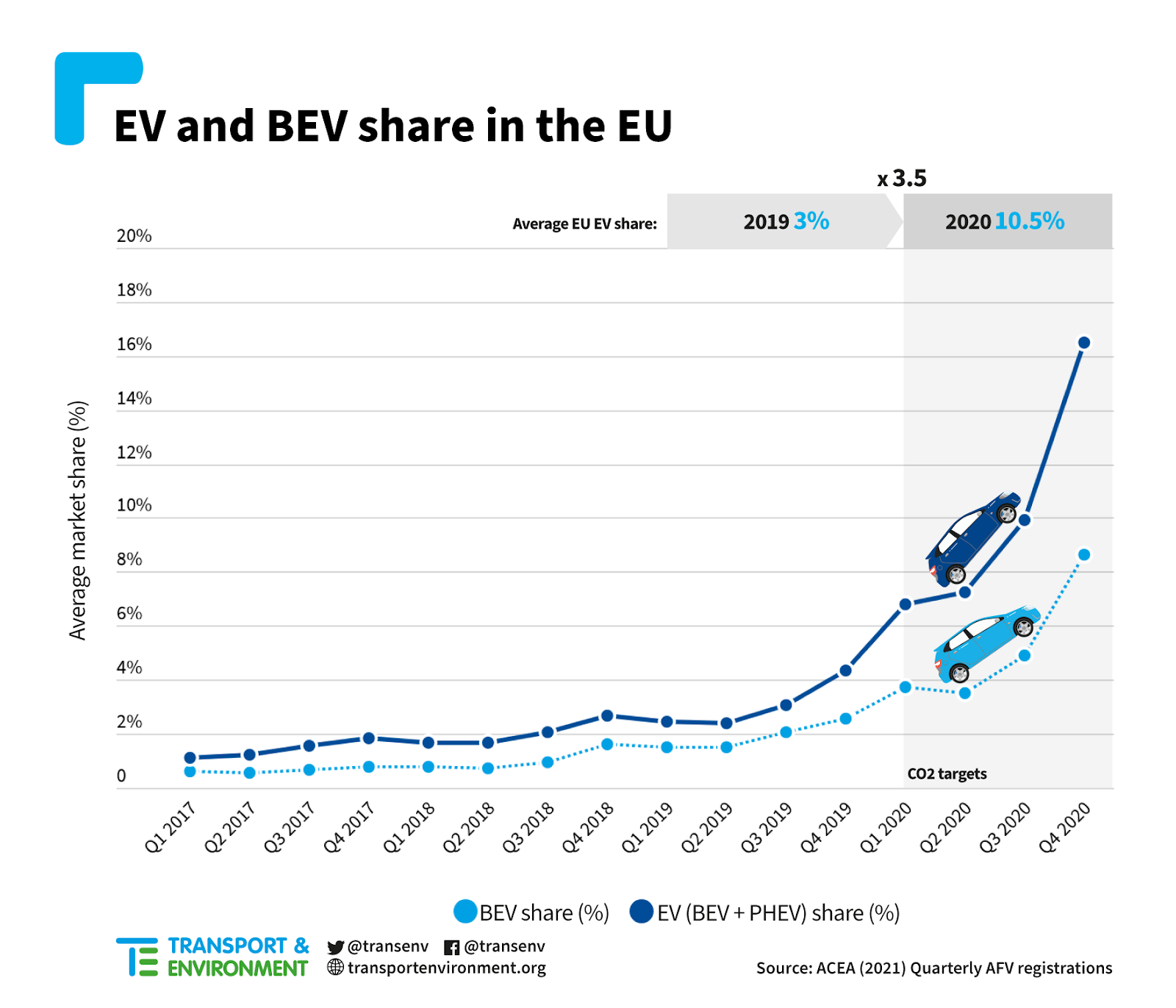The year of the electric vehicle
2020 was the most productive year to date in tackling the greatest source of transport emissions: internal combustion engine cars. It was the year of the electric vehicle in Europe, and it began with the quiet entry into force of the long awaited EU 2020/21 car CO2 targets. These require carmakers to invest in clean technology, mostly electric cars, and reduce carbon pollution from their car sales to 95g/km on average. Huge investments, a large selection of plug-in models and soaring sales followed. By the end of 2020 EVs made up 10.5% of sales across Europe, more than triple the previous year. T&E captured the trend in its annual cars CO2 report, positively dubbing it ‘Mission Accomplished’. It goes without saying, there has never been a better time to buy a plug-in vehicle.

No backsliding
A strong start to the year for EV sales looked to be derailed by the Covid crisis which drove Europe into lockdowns and economic uncertainty. With car dealerships closed through spring and delays in the production of new models, there were calls within the car industry to delay and relax the rules. In response, T&E assembled a coalition of cities, companies and NGOs to convince the European Commission to stay the course. The crisis was not an excuse to roll back climate progress, instead it was an opportunity to accelerate the green transition.
Recovery plans represented such an opportunity. Similar purchase subsidies and scrappage schemes in the aftermath of the financial crisis in 2008 helped consumers to buy new diesel and petrol cars. But more than a decade later, politicians stood firm against the industry’s demands to subsidise all cars. This time round funding in Germany, France and – to a large extent – Spain and Italy focused on supporting sales of electric and low-emission models. The zero emissions momentum was back on track once again.
Tightening car CO2 standards
In September the Commission unveiled its plans to ramp up its 2030 climate ambitions to put itself on course for a zero-emission economy by 2050. The Commission announced plans to increase the 2030 car CO2 target and flagged the idea of setting an EU-wide end date for the sales of internal combustion engine technology. To support the electric momentum, it committed to the roll-out of one million public charge points by 2025, similar to what T&E recommended early in the year in its RechargeEU analysis.
However, despite this acceleration in EV sales, the EU risks slowing down if car CO2 standards between 2025 and 2030 are not tightened. This will be the battleground over the next year which will determine whether Europe picks up speed or slows down.
Elsewhere
Uber to electrify half its European fleet
Uber will provide 50% of its rides in emissions-free vehicles across seven European capitals by 2025 following an 11-month campaign by Transport & Environment and seven NGO partners. The world’s largest mobility platform pledged to clean up its act in Amsterdam, Berlin, Brussels, Lisbon, London, Madrid and Paris in response to the #TrueCostOfUber campaign, which urged it to ditch dirty vehicles and replace them with electric cars.
A first ever sustainable battery law
The end of the year saw proposals to make battery supply chains ethical and more sustainable. A draft battery law was announced by the European Commission mirroring T&E priorities on batteries since the group joined the European Battery Alliance in 2017. This included lowering battery carbon footprint, ethical sourcing via mandatory due diligence and recovery targets (recycling) for key materials such as cobalt and nickel.
Exposing the plug-in con
With half of plug-in sales being plug-in hybrids in 2020, T&E tested and assembled evidence to expose the climate risks these “fake electric” cars pose. Often not designed to be driven in electric mode in real-world conditions, these large cars with small batteries often spew three to four times the CO2 levels that they advertise. Tightening the tests, reforming the tax incentives and allowing only zero emission cars to get rewards under the Car CO2 rules are all needed to close the current plug-in con.